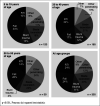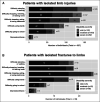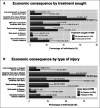Limb Injuries and Disability in the Southwest Region of Cameroon
- PMID: 36795867
- PMCID: PMC9937092
- DOI: 10.5435/JAAOSGlobal-D-22-00148
Limb Injuries and Disability in the Southwest Region of Cameroon
Abstract
Introduction: Extremity injuries are a leading cause of morbidity in low- and middle-income countries (LMICs), often resulting in marked short-term and long-term disabilities. Most of the existing knowledge on these injuries originates from hospital-based studies; however, poor access to health care in LMICs limits these data because of inherent selection bias. This subanalysis of a larger population-level cross-sectional study in the Southwest Region of Cameroon aims to determine patterns of limb injury, treatment-seeking behaviors, and predictors of disability.
Methods: Households were surveyed in 2017 on injuries and subsequent disability sustained over the previous 12 months using a three-stage cluster sampling framework. Subgroups were compared using the chi square, Fisher exact, analysis of variance, Wald, and Wilcoxon rank-sum tests. Logarithmic models were used to identify predictors of disability.
Results: Of 8,065 subjects, 335 persons (4.2%) sustained 363 isolated limb injuries. Over half of the isolated limb injuries (55.7%) were open wounds while 9.6% were fractures. Isolated limb injuries most commonly occurred in younger men and resulted from falls (24.3%) and road traffic injuries (23.5%). High rates of disability were reported, with 39% reporting difficulty with activities of daily living. Compared with individuals with other types of limb injuries, those with fractures were six times more likely to seek a traditional healer first for care (40% versus 6.7%), 5.3 times (95% CI, 1.21 to 23.42) more likely to have any level of disability after adjustment for injury mechanism, and 2.3 times more likely to have difficulty paying for food or rent (54.8% versus 23.7%).
Discussion: Most traumatic injuries sustained in LMICs involve limb injuries and often result in high levels of disability that affect individuals during their most productive years. Improved access to care and injury control measures, such as road safety training and improvements to transportation and trauma response infrastructure, are needed to reduce these injuries.
Copyright © 2023 The Authors. Published by Wolters Kluwer Health, Inc. on behalf of the American Academy of Orthopaedic Surgeons.
Figures




References
-
- World Health Organization: Biennal Report 2010/2011: Violence, Injury and Disability, Vol 1-17, Geneva, Switzerland: World Health Organization, 2012.
-
- Chichom Mefire A, Etoundi Mballa GA, Azabji Kenfack M, Juillard C, Stevens K: Hospital-based injury data from level III institution in Cameroon: Retrospective analysis of the present registration system. Injury 2013;44:139-143. - PubMed
-
- Petroze RT, Joharifard S, Groen RS, et al. : Injury, disability and access to care in Rwanda: Results of a nationwide cross-sectional population study. World J Surg 2015;39:62-69. - PubMed
-
- Botchey IM, Hung YW, Bachani AM, et al. : Epidemiology and outcomes of injuries in Kenya: A multisite surveillance study. Surgery 2017;162:S45-S53. - PubMed

